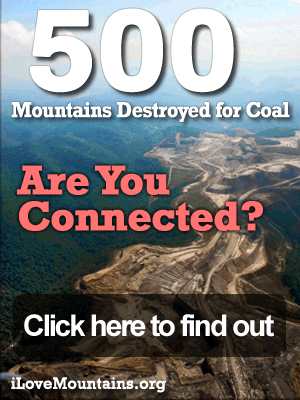

BLOGGER INDEX
JW Randolph
Raised on the banks of the Tennessee River, JW's work to create progress in his home state and throughout Appalachia has been featured on the Rachel Maddow Show, The Daily Kos and Grist. He served first as Appalachian Voices’ Legislative Associate and then Tennessee director until leaving to pursue a career in medicine in 2012.Head of the Holler – James Reams & The Barnstormers
Wednesday, December 5th, 2007 | Posted by JW Randolph | No Comments
Tree-Lover Gooch?
Sunday, November 18th, 2007 | Posted by JW Randolph | No Comments
 Kentucky made headlines this week, when the great Gooch! (Rep. Jim Gooch) – Chairman of Kentucky’s House Natural Resources and Environment Committee – held a hearing challenging the validity of global warming. Its been noted that Gooch has been friendly to coal interests for years.
Kentucky made headlines this week, when the great Gooch! (Rep. Jim Gooch) – Chairman of Kentucky’s House Natural Resources and Environment Committee – held a hearing challenging the validity of global warming. Its been noted that Gooch has been friendly to coal interests for years.
Yesterday, Gooch denied any suggestion that he favors coal interests over ecological concerns
“I care as much about our environment as anybody,” he said. “I’m a tree lover. Not a tree hugger necessarily, but a tree lover.“
But this time, other Democrats tossed around the idea of removing Tree-Lover Gooch from his chairmanship.
“It’s a good thing the writers are on strike in Hollywood so we don’t wind up on the late-night comedy shows again,” said Rep. Kathy Stein, D-Lexington, chairwoman of the House Judiciary Committee. “His committee meeting was a laughable farce — or it would have been, if it wasn’t so scary.”
The eventually decided to keep Tree-Lover in his chairmanship position, and Kentucky will continue to have its beautiful mountains and natural resources defended by Mr. Flintsone Gooch.
But, as much as he loves trees, might his financial dealings present a conflict of interest?
Gooch, 56, and his brother own West Kentucky Steel Construction Co., which sells mining equipment to Peabody Energy, Arch Coal and other coal companies.
Gooch, who consistently wins re-election in his district with about 75 percent of the vote, has taken at least $11,750 in coal-related donations for his modest campaigns since 1998.
We’ll keep you posted.
In a related story, Kentuckians rid themselves last week of Governor Ernie Flecther, a champion of mountaintop removal mining. Well, we’ve yet to understand if Governor elect Beshear will improve environmental standards around the state.
It might be a long-shot, as Beshear’s position is that “ we only need to practice the mountaintop removal we need to practice.
The candidates also went head-to-head about regulations on mountaintop removal and damages to the environment that this form of mining causes.
“I think it is important to limit the times when mountaintop removal is used,” Beshear said. “We have to keep it as an exception, as a rare time when companies aren’t required to restore the land they disturb, and not as the general practice.”
Fletcher agreed that it is important to enforce the laws that are in place to protect the mined areas.
“I think we do a good job of enforcing those land restoration regulations,” Fletcher said. “I believe the land in most of those areas has been well restored. Yes, the mountain sees significant change, but that happens with floods and with glaciers or tornadoes or in any case of a natural disaster.”
Sweet. A glacier.
The Great American “Resource Curse”
Wednesday, November 14th, 2007 | Posted by JW Randolph | 1 Comment
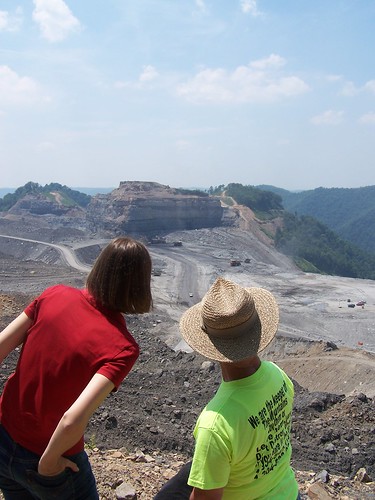 Most of us have seen what mountaintop removal (MTR) does to our beloved mountains and precious headwaters. We’ve heard anecdotes from the people who live there. We’ve even gotten the scoop from our beltway champion, Congressman Pallone on DailyKos the other day.
Most of us have seen what mountaintop removal (MTR) does to our beloved mountains and precious headwaters. We’ve heard anecdotes from the people who live there. We’ve even gotten the scoop from our beltway champion, Congressman Pallone on DailyKos the other day.
Mountaintop removal is devastating to the environment. That much is obvious.
Furthering the discussion, I propose we start our conversation today on jobs and the economy with (as is becoming trademark…) an incredibly articulate chart.

The more we use mountaintop removal, the fewer mining jobs there will be.
Those of us who are fighting for Appalachia, and work daily to stop mountaintop removal are on the right side of the “jobs” argument. There. I said it.
Now hop in!
…
Part I. The Resource Curse
In 1995, Harvard economists Jeffery Sachs and Andrew Warner discovered a clear negative relationship between natural resource-base exports, including agriculture, minerals, and fuels, and GDP growth. Of the 95 countries they investigated, only two achieved a 2% annual GDP growth rate between 1970-1989. A more common occurence was increased poverty, warfare, and civil strife. They dubbed this phenomenon “ The Resource Curse.”
Electric power generation pulled in more than $380 billion in 2005. More than half of that electricity generation came from coal. Coal companies have been here for over 150 years…so why are the people of Appalachia the poorest in the country? Why aren’t we dancing on streets paved with gold? Because, I’ll tell you, coal barons are obsessed with protecting jobs!. They’ll gladly tell you, the most important thing in the world is not clean air, clean water, or healthy communities, but…
1) Jobs
2) Jobs!
3) JOBS!!!
4) air, water, safety, plastic Chinese crap, etc.
Part II: JOBS!!!
Nick Rahall (WV-03) :
Yes coal provides a livelihood to a vast number of people in my district and in West Virginia. Yes, coal is a friend to West Virginia.
Burlington Northern Santa Fe (BNSF) (railroad) CEO Matt Rose:
If an environmental bill is passed [that caps Carbon Dioxide emissions], employment would be cut in half. or more, because coal would be seriously hurt or even eliminated.
Bill Raney, President, WV Coal Foundation:
The state’s coal industry is providing good jobs, while performing quality reclamation. Unfortunately, the industry and its workers “are threatened by these frivolous lawsuits and continued attacks.”…
…Rahall told Raney that his testimony was “right on target.”
In 1999, Senator Robert C. Byrd offered an amendment to allow increased mountaintop removal mining, and weakened laws regarding the dumping of the toxic waste. Several prominent Democrats, including Senators Dodd, and Edwards, and Reid voted for it.
Sen. Byrd:
[this amendment is] to allow for the continuation of our coal industry and the jobs it provides while better protecting the mountains and hollows of the state we love.”
At which point I point them to my favorite graph:

Surface mining (which includes MTR mining), accounts for only 1.2% of jobs in WV and brings in just 2.6% of the state’s total revenues. The counties where surface mining predominates are some of the still poorest counties in the country.

From my favorite book “Big Coal,” by Jeff Goodell:
Today, there are more florists in America than there are coal-miners. And if coal mining were the sure-fire ticket to wealth and prosperity that many in the industry claim, West Virginians would be dancing on gold-paved streets.
…
Over the past 150 years or so, more than 13 billion tons of coal have been carted out of the mountain state. What do West Virginians have to show for it? The lowest median household income in the nation, a literacy rate in the southern coalfields that’s about the same as Kabul’s, and a generation of young people who are abandoning their home state to seek their fortunes elsewhere.
There was a time when coal employed over 150,000 people. Now, in West Virginia, there are less than 15,000 miners.
Part III: Streets of gold
Areas where mountaintop removal and strip-mining take place are near the bottom in every economic indicator. It’s important to note that MTR and strip-mining are not the only factors, but that they are just a part of coal’s century old policy of ignoring and disrespecting the basic American needs of the people in Appalachia.
Coal companies undercut every other industry, and keep the state at the mercy of the 5% severance tax which they provide to the state treasury every year. A cut in the state income would mean cutbacks in services essential to an impoverished people. This is a convenient carrot for Massey Energy to hold out to Appalachian politicians.
Mr. Byrd, Mr. Rahall, Mr. Boucher, please take note.
The Appalachian economy is in shambles, the mountains are being destroyed, the water is being poisoned, and we are at the bottom of the barrel for every economic indicator.
To provide America cheap energy? NO!
The price of Central Appalachian coal has more than doubled in the last decade. It is now the most expensive coal in domestic markets, and states like Virginia (which uses MTR) are importing coal from Indonesia.

For the betterment of Appalachia and its people? NO!
People are literally being driven from coalfields.
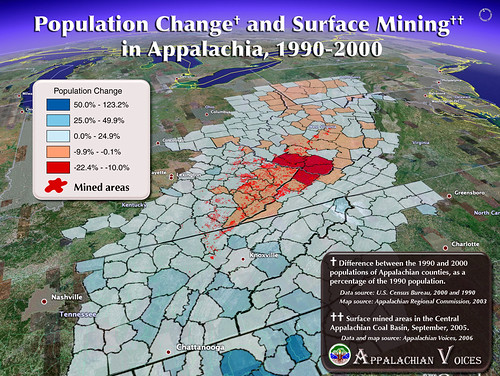
This is part of a long-planned and deliberate attempt to remove those pesky “people” from these mountains to get at the resources underneath. If you don’t believe that anyone could do such a thing in the United States of America, a coal-company lawyer H.L. Snyder outlines his “depopulation plan” right here on the internets (.pdf). He’ll say it much more eloquently than I can.
From Jeff Goodell:
Economists don’t offer many easy explanations of why the [resource] curse clings to some countries and not to others, but most would agree that two factors are crucial for success: investment in education, and a transparent political process
In many regions in the coalfields, a High School education is something to brag about.
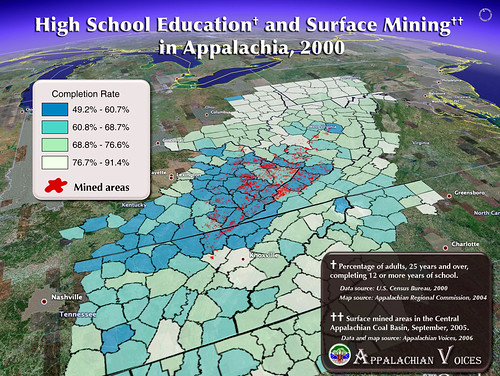
A motivated but unskilled workforce, and almost complete automation of labor lead to high unemployment and jobs where income is minimal.
We are, therefore, among the most impoverished people in the nation.

Coal has systematically enshrined Appalachian poverty :
A 1983 study of 80 counties in six Appalachian states, including West Virginia, says, “Corporations alone held 70 percent of all mineral rights. Viewed from another angle, 1 percent of the owners controlled 53 percent of the land, a state of affairs that has contributed to the region’s chronic poverty.” Indeed, some of West Virginia’s top coal-mining counties are plagued by chronic poverty. The percentage of people living at or below poverty in Boone County is 18.4. In Logan County, it’s 21 percent, and in Mingo County, 24.7. The state average is 16.3 percent, and nationally it’s 12.5 percent. – Janet Keating
Where does all this coal money go? We should be dancing on streets of gold right?
Hardly.
I encourage you to explore the full list of Big Coal’s favorite recipients in Congress, here.
Other than politicians and coal company CEOs, there are few workers who benefit. We have to face the fact that despite its inverse relationship to job creation, mountaintop removal sites employs people in the coal producing regions of Appalachia. And yet, with mountaintop removal, we then must ask ourselves, How far exactly are we willing to go to “employ” someone? Just because they get a paycheck, does that mean that they can tear down our mountains, poison our water, and destroy our communities? Does that mean we can put the very lives we live in danger?
Part IV: Where do we go from coal?
I have previously explored how to turn a mountaintop removal economy into a sustainable Appalachian wind economy here. If you have a moment, please glance at it and let me know your thoughts.
Tourism already employs far more people in WV than coal does, and should continue to do so as long as we have beautiful mountains. And the recreation/food services industry employs almost twice as many workers as the forestry/mining industry in West Virginia.
The jobs are there. We are on the right side of history and this debate, and we must go green. The future is a green collar economy or bust!
Jeff Goodell:
A full-blown push for clean energy could unleash a jobs bonanza that would make what happened in Silicon Valley in the 1990s look like a bake sale.
A Siegel explores these issues on an almost daily basis, so I highly recommend reading his daily explorations into the exciting wonky world of energy economy.
Part V: Stopping mountaintop removal
As my favorite political cartoonist Bruce Plante illustrates here, mountaintop removal is something that people hate across the political spectrum.

But you can (and must) help.
Congressmen Pallone and Shays have reintroduced the Clean Water Protection Act (HR 2169) as a first step in ending the terrible practice of mountaintop removal coal-mining. As Mr. Pallone announced in his diary here last week, we are now up to 111 bi-partisan co-sponsors. Please call your Congressman and demand that they lift the resource curse of Appalachia, start building a green collar economy here in Appalachia, and co-sponsor the Clean Water Protection Act (HR 2169.)
To see if your Congressman is a co-sponsor, please click here.
If you have already called your Congressman, and want extra credit, please consider calling these key members of the Water Resources Subcommittee, where the HR 2169 will go first.
| Name | District | Local # | D.C. # |
| Eddie Bernice Johnson | TX-30 | (214) 922-8885 | (202) 225-8885 |
| Gene Taylor | MS-4 | (228) 864-7670 | (202 225-5772 |
| Brian Baird | WA-3 | (360) 695-6292 | (202) 225-3536 |
| Jerry Costello | IL-12 | (618) 233-8026 | (202) 225-5661 |
| Russ Carnahan | MO-3 | (314) 962-1523 | (202) 225-2671 |
| John Salazar | CO-3 | (970) 245-7107 | (202) 225-4761 |
| Mazie Hirono | HI-2 | (808) 541-1986 | (202) 225-4906 |
| Harry Mitchell | AZ-5 | (480) 946-2411 | (202) 225-2190 |
| Steve Kagen | WI-8 | (920) 437-1954 | (202) 225-5665 |
| Grace Napolitano | CA-38 | (562) 801-2134 | (202) 225-5256 |
| NY-24 | (315) 252-2777 | (202) 225-3665 |
Arcuri is crossed off because, thanks to the hard work of many folks across the country, on Thursday he became the 110th co-sponsor of the Clean Water Protection Act (HR 2169). Keep it up!
Is John Edwards Coming Around on Mountaintop Removal?
Monday, November 12th, 2007 | Posted by JW Randolph | No Comments
Senator John Edwards, Democratic Presidential hopeful, notoriously voted to increase mountintop removal mining in 1999. While the vote he cast was for an amendment that never made it into law, Senator Edwards has never explicitly stated that he regrets voting for increased mountaintop removal and the dumping of mountaintop removal waste. While he is strong on a host of other issues, he had not officially come out against mountaintop removal this cycle, to my knowledge (please correct me in the comments if you know differently.)
That is, unitl recently, when his position regarding mountaintop removal seems to be…evolving.

One FOTPC reported that after the event she asked Edwards if he would stop mountain top removal to which he answered yes. The FOTPC shared this website(iLoveMountains.org) and video with TPC about getting coal from mountains in Appalachia.
This is very encouraging. In February of this year he was a little wishy-washy:
n particular, one community member questioned Edwards on his Senate vote approving mountain-top removal coal-mining. The question was prompted by a pamphlet distributed by Sustainable Dartmouth’s new political taskforce. The pamphlet contained quotes from Edwards on his opinions on several environmental issues and included a five-year rating of the former senator on his voting record by the League of Conservation Voters, as well as summaries of his environmental votes. Edwards said he thought his vote was the result of political realities at the time and reiterated his pro-environment stance.
I’d really like to have an official word from the campaign. If you have a moment please call Mr. Edwards’ campaign and ask if he officially opposes mountaintop removal, and has plans to stop the practice if elected president.
Edwards for President – (919) 636-3131
Powershift 2007
Sunday, November 11th, 2007 | Posted by JW Randolph | No Comments
I was fortunate to be a part of the Powershift 2007 conference in Washington DC, where over 6,000 young people came to learn, teach each other, and lobby Congress on climate change, mountaintop removal, and ending American reliance on dirty fossil fuels. Turns out we made MTV news 🙂
-
Big Coal is Desperate
Saturday, November 10th, 2007 | Posted by JW Randolph | No Comments
After Kansas rejected an unnceccesary coal-fired power plant, big coal started running this hilarious (and pathetically desperate) attack ad.

Kansans are actually smiling because a coal-fired power plant was denied in their state, becoming the first to be denied because of deadly global warming Carbon Dioxide emissions.
Action at CitiBank in Washington, DC
Friday, November 9th, 2007 | Posted by JW Randolph | No Comments
Congrats to our friends at RAN. The action was peaceful, and not a single individual was arrested.
Also, from RAN, this hilarious pardoy of the recent barage of “clean coal” commercials:
Watauga High School to be First Green “LEED certified” in NC
Friday, November 9th, 2007 | Posted by JW Randolph | No Comments
Thanks to some hard-work of many local activists and elected officials, Boone’s new “Watauga High School” will be the first in North Carolina to earn LEED certification.

Commission chairman Jim Deal said it would be collaborative project, with ASU instructors using the project as a demonstration model. Participating students would earn credit and gain experience in “green” building, engineering and certifying procedures.
LEED was developed in 1998 by the U.S. Green Building Council, setting a series of ratings that must be met to achieve the certification. While credentials for commercial buildings and homes are already in use, the “LEED for Schools” designation was formally adopted in April, which would likely make the new high school the first in North Carolina to be built according to those guidelines.
The county could pursue a “Silver LEEDS” certification, one of four different levels granted through achieving performance benchmarks. Among the green techniques discussed for the school are the strategic placement of windows for daytime interior lighting, capturing and reusing rainwater, and a geothermal collection system that would use underground pipes for heating and cooling.
Commissioner Mary Moretz said while the county would face additional costs up front, the techniques would result in long-term savings, particularly given the collaboration with ASU.
I’m proud! Congratulations to all our friends in Watauga County.
Appalachian Coal: the faucet is almost dry
Tuesday, October 30th, 2007 | Posted by JW Randolph | No Comments
The issues with coal-fired power plant emissions are well chronicled – increased lung and cardiovascular disease, loss of visibility, and (somewhat importantly) the complete shattering of our global climactic patterns.
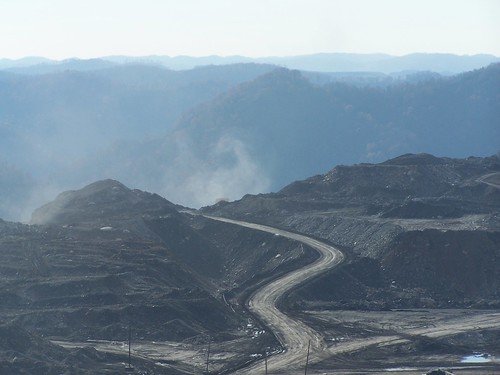 Many are also seeing for the first time that extracting coal is as destructive (and socially expensive) as emitting coal. Mountaintop removal and strip mining are decimating the majestic Appalachian Mountains – the oldest mountains on this continent. More than 1 million acres have been blasted away, and shoved recklessly into creek-beds and hollows. 1200+ miles of headwater streams have been buried, poisoning the water for us and those who live down stream.
Many are also seeing for the first time that extracting coal is as destructive (and socially expensive) as emitting coal. Mountaintop removal and strip mining are decimating the majestic Appalachian Mountains – the oldest mountains on this continent. More than 1 million acres have been blasted away, and shoved recklessly into creek-beds and hollows. 1200+ miles of headwater streams have been buried, poisoning the water for us and those who live down stream. The ancient hardwood forests of Appalachia (themselves an important carbon sink in our war on CO2) are often shoved aside with the mountain, left to rot and clog our streams without even being commercially harvested. The “rape” of Appalachia, as Senator Webb has called it.
How much coal would be “worth it?”
100 years?
250 years?
500 years?Hows about a dozen?
…
Well, I know “science” isn’t the most popular thing in Washington these days, but according to “facts” we are sitting on AT MOST a mere 10-15 years of coal in the Appalachians.
Take a look at the region carrying the heaviest load for American coal production, and you’ll see that we are definitively beyond “peak coal” in Appalachia.
So says the USGS…
“Sufficient high-quality, thick, bituminous resources remain in [Appalachian Basin] coal beds and coal zones to last for the next one to two decades at current production.”
– United States Geological Survey (USGS), 2000 AD
So says the Department of Energy…
“[2002-2005] is the first time the Appalachian Region has experienced four consecutive years of coal production of less than 400 million short tons since the 1960s.”
– DOE/EIA-0584 (2005) Annual Coal Report 200516
So says Public Utilities Fortnightly:
Central Appalachia proved-in-place production capacity declined by 8 million tons per year in 2005, despite record level price signals since late 2003. ”
From: “A Wakeup Call for Coal” – Public Utilities Fortnightly, December, 2006
by Gary L. Hunt and Hans Daniels of Global Energy Advisors5To get a better picture of what is happening, zoom in even closer on a state like Virginia:
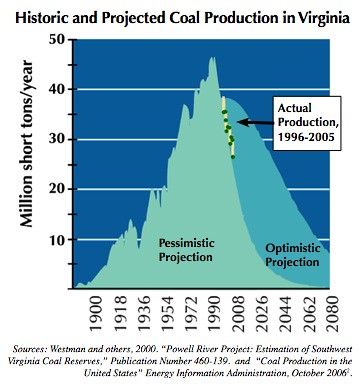
Both projections see Appalachian coal production dropping at an alarming rate. But you will see that production, looking at actual outputs, actually follows the pessimistic projection in the regional picture.
This means that Appalachian coal is on its way to bust. Because of the expense of moving an entire mountain to get to the little coal we have left, the cost of Appalachian coal has DOUBLED in the last decade. And they tell us they are blowing up our mountains to give us cheap electricity!?

In fact, central Appalachian coal is now the most expensive on the domestic market (page 4 of .pdf)
The Appalachian Mountains have lost 6 kilometers in height over millions of year of natural weathering and erosion, churning ancient Carboniferous Era forest into that magical rock – coal. Now, mountaintop by mountaintop, the Appalachians are being removed from the earth once and for all. And at what gain?
1) To produce jobs?
No. Mountaintop removal is used specifically because it employs (significantly) fewer workers.2) To produce energy?
No. Mountaintop removal supplies just 5% of our energy. You can only burn coal one time, and we can supply a far greater amount of energy through conservation, efficiency, and green power annually.3) To bring the people of Appalachia the “flat land” we always “needed?”
No. Less than 1% of reclaimed sites are used commercially. One or two are remade into golf courses or prisons. But the ones that the politicians don’t see look like this…
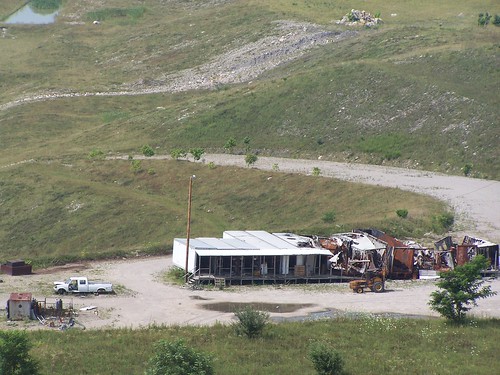
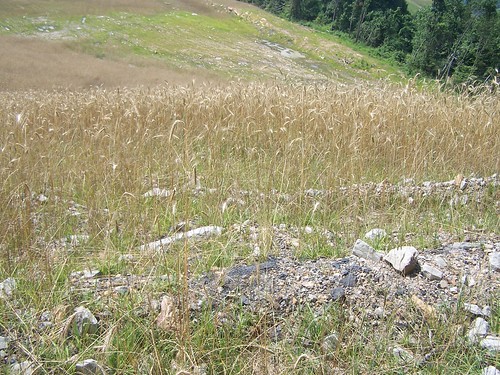
(Pictures taken 10+ years into “reclamation process”)BUT THERE IS A WAY YOU CAN HELP
The Clean Water Protection Act (HR 2169) is a simple bill that would slow and even stop most mountaintop removal coal-mining. This simple two sentence bill would reverse the Bush Administration’s 2002 decision that the toxic “waste” from mountaintop removal sites could be defined as “fill material” and dumped into our water ways.
Please take a few minutes and see if your Congressperson is a co-sponsor of the Clean Water Protection Act (HR 2169).
If they are a co-sponsor of HR 2169, thank them.
If they are not, contact them and ask them to “Co-sponsor the Clean Water Protection Act” (HR 2169).
If you have contacted them, and would like to do more, please help us work on the following targets. They are of national importance because of their seats on the “Water Resources Subcommittee,” where the “Clean Water Protection Act (HR 2169) will go first.
Eddie Bernice Johnson (TX-30) (Chairwoman)
202-225-8885
214-922-8885Brian Baird (WA-03)
202-225-3536
360-695-6292Russ Carnahan (MO-03)
202-225-2671
314-962-1523John T. Salazar (CO-03)
202-225-4761
970-245-7107Mazie K. Hirono (HI-02)
202-225-4906
808-541-1986Grace F. Napolitano (CA-38)
202-225-5256
562-860-5050Michael A. Arcuri (NY-24)
202-225-3665
315-793-8146Another great way to be involved is to participate in DevilsTower’s “30 days for the mountains” series at DailyKos. Please leave comments and participate as you are able.

